Tenochtitlan › Maya Civilization » Ancient origins
Articles and Definitions › Contents
- Tenochtitlan › Ancient History
- Maya Civilization › Antique Origins
Ancient civilizations › Historical and archaeological sites
Tenochtitlan › Ancient History
Definition and Origins
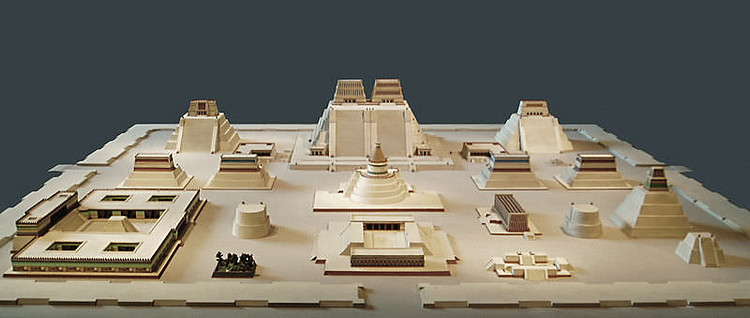
Tenochtitlan, located on an island near the western shore of Lake Texcoco in central Mexico, was the capital city and religious centre of the Aztec civilization. The traditional founding date of the city was 1345 CE and it remained the most important Aztec centre until its destruction at the hands of the conquering Spanish led by Hernán Cortés in 1521 CE, which led to the final collapse of the Aztec Empire. At the heart of the city was a large sacred precinct dominated by the huge pyramid, known as the Temple Mayor, which honoured the gods Huitzilopochtli and Tlaloc. The site, now Mexico City, continues to be excavated and has yielded some of the greatest treasures of Aztec art such as the celebrated Sun Stone as well as art objects the Aztecs themselves collected from the other great civilizations of Mesoamerica.
IN MYTHOLOGY
In Aztec mythology the founders of the city migrated from the legendary Aztlán cave in the northwest desert which involved a protracted journey that eventually led to Lake Texcoco. During this migration priests had carried a huge idol of the god Huitzilopochtli, who whispered directions, gave the Méxica their name and promised great wealth and prosperity if he was suitably worshipped. Along the way the Méxica settled at different spots, none of which really suited their purpose. A decisive event in the migration was the rebellion incited by Copil, son of Huitzilopochtli's sister Malinalxochitl. This was in revenge for the goddess' abandonment by the Méxica but with Huitzilopochtli's help Copil was killed. The great war god instructed that the rebel's heart be thrown as far as possible into Lake Texcoco and where it landed would indicate the place the Méxica should build their new home, the precise spot being marked by an eagle sitting on a prickly-pear cactus ( nopal ) and devouring a snake. This is exactly what came to pass and the new capital of Tenochtitlan was built, the traditional date being 1345 CE.
The name of the city derives from tetl meaning rock, nochtli, the prickly-pear cactus and tlan, the locative suffix. Of similar origin is the term Tenocha which the Méxica sometimes called themselves and the name of their quasi-legendary priest-leader Tenoch.
TENOCHTITLAN WAS ONE OF THE GREATEST CITIES IN MESOAMERICA WITH OVER 200,000 RESIDENTS.
THE CITY
Although the city was destroyed and over the following centuries extensively built over, the chroniclers of the 16th century CE, fortunately, recorded in great detail the buildings and works of art that had once made Tenochtitlan one of the greatest cities in Mesoamerica and, with over 200,000 residents, certainly the most populous. These records and the extensive and continuing archaeology at the site mean that we know more about Tenochtitlan than any other city from the great Mesoamerican civilizations.
As Bernal Diaz del Castillo, one of Cortés' men put it on first seeing the city:
It was like the enchantments in the book of Amadis, because of high towers, rues [ pyramids ] and other buildings, all of masonry, which rose from the water. Some of the soldiers asked if what they saw was not a dream.
(Miller, 239)
Tenochtitlan covered, at its greatest extent, some 12-14 km² and was connected to the western shore of the lake and surrounding countryside by three causeways (running north, east and west) which included gaps traversed by removable bridges to allow boats to pass and which could be taken down in case of an attack on the city (something which never occurred until the Spanish arrived). There was also a stone aqueduct which brought fresh water to the city from springs near the Chapultepec Hill. The lake provided an important source of food but good agricultural land was scarce and this fact would necessitate re-claiming land from the lake and, eventually, military conquest to take land by force from neighbouring states.The surrounding chinampa or 'floating gardens' (mud rafts secured with willow trees) of their immediate neighbours were, therefore, seized and developed to meet the needs of the growing population in the city.
The city itself was laid out in a grid pattern with many canals permeating through the city. Besides the four main thoroughfares dissecting the city along the cardinal directions, most streets and canals were narrow, especially as there were no wheeled vehicles or beasts of burden so that goods were transported by porter or small boats and canoes. The canals, along with the many willow trees, flower gardens and white-plastered monuments gleaming in the sunlight, must have made for a picturesque city. As one Nahuatl poem describes:
The city is spread out in circles of jade,
radiating flashes of light like quetzal plumes,
Besides it the lords are borne in boats:
over them extends flowery mist.
(Coe, 192)
The heart of the city was the walled ceremonial precinct with its three entrances, impressive temples and pyramids from which the city spread out into four principal residential quarters. These had sometimes vast palaces such as Motecuhzoma I's old residence and the palace of Axayacatl, smaller flat-roofed stone residences for nobles and officials, huge market places (where all manner of basic and luxury goods could be purchased such as jade, chocolate and vanilla), judicial chambers, treasure houses, store-rooms, structures such as the Dance House and the Aviary, and closely packed areas of workshops (working especially metal and obsidian but also basketry using the local reeds) and small adobe brick and reed homes where the lower classes lived, although these too could be interspersed with small gardens.
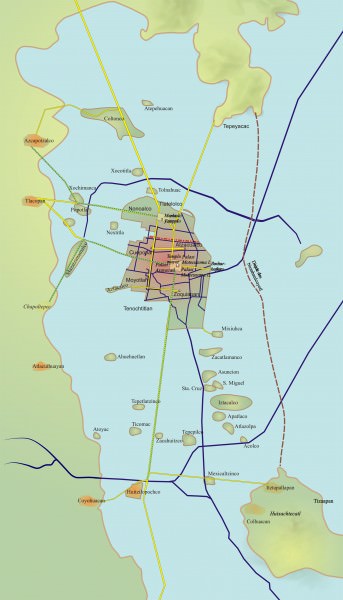
Tenochtitlan
THE SACRED PRECINCT
The sacred precinct at the heart of Tenochtitlan contained, according to one eye-witness, 78 separate structures. Amongst the most important were the Temple Mayor of Tlaloc and Huitzilopochtli, which was flanked by the Eagle's House (named after its stone decoration) on one side and the pyramid of Tezcatlipoca on the other. In front of the Temple Mayor stood the gladiatorstone (where sacrificial victims were bound and attacked by 'knights'), a stone tzompantli (skull rack) and an I-shaped ball court. In the south west corner stood the Sun Temple of Tonatiuh and a temple to Quetzalcoatl.
There was also a temple to the earth goddess Tonantzin and the Coateocalli building which housed, and in a sense spiritually captured, the statues of gods and various other artworks captured from conquered enemies. Finally, on the Tlaloc side of the Temple Mayor excavations have revealed a man-made mountain made of offerings and deposits which was designed to imitate Tlaloc's sacred mountain.
THE TEMPLE MAYOR
The Great Temple or Temple Mayor (called Hueteocalli by the Aztecs) takes centre stage in the sacred precinct. On top of the 60 m high pyramid platform, reached by two flights of steps, were two twin temples. The north side shrine was dedicated to Tlaloc, the god of rain and the other, on the south side, was dedicated to Huitzilopochtli, the god of war. The temple to Tlaloc marked the summer solstice (symbolic of the wet season) whilst Huitzilopochtli's marked the winter solstice (symbolic of the dry season and a time for warfare ). The monumental steps leading to Tlaloc's temple were painted blue and white, the former colour representing water, the element so strongly associated with the god. In contrast, the steps leading to Huitzilopochtli's temple were painted bright red to symbolise blood and war.
Sacrifices, including human ones, were carried out at both temples to feed and honour the gods. A typical sacrifice involved the victim having their heart ripped out, being skinned, decapitated and then dismembered. Following all that the corpse was flung down the steps of the pyramid to land at the base where a massive round stone depicted Coyolxauhqui, the goddess who was similarly treated by Huitzilopochtli in mythology.

Temple Mayor, Tenochtitlan
DESTRUCTION
When the Spanish arrived at Tenochtitlan, their leader Cortés had only 500 men and fewer than 20 horses at his disposal.However, by recruiting allies such as the Tlaxcalans, he was able to lay siege to the city which would eventually fall on the 13th of August 1521 CE. The great monuments were sacked and looted, works of art and precious objects were melted down and the Aztec civilization collapsed. What was left of the city was made into the capital of New Spain, as the Spanish called their new colony.
ARCHAEOLOGY
Excavations within the temples and buildings of Tenochtitlan began in the 20th century CE and have revealed the true complexity of the site's history. There is evidence, for example, that the sacred precinct was built over much earlier structures, that the temples themselves were reconstructed and added to many times and within them were buried offerings, for example, the coral, shells and sea-life interred deep within the Temple Mayor.
The city was stripped of anything of value following its collapse but, nevertheless, several stunning works of art have been, almost miraculously, recovered from Tenochtitlan. These include the iconic Sun Stone (aka Calendar Stone ), the great stone sculpture of Coatlicue, the Tizoc stone, the huge round stone depicting Coyolxauhqui which rested at the foot of the Temple Mayor, the Temple Stone - a stone throne probably used by Motecuhzoma II and decorated with gods and a sun disk, and finally, the blue ceramic anthropomorphic vessel depicting Tlaloc.
The city was stripped of anything of value following its collapse but, nevertheless, several stunning works of art have been, almost miraculously, recovered from Tenochtitlan. These include the iconic Sun Stone (aka Calendar Stone ), the great stone sculpture of Coatlicue, the Tizoc stone, the huge round stone depicting Coyolxauhqui which rested at the foot of the Temple Mayor, the Temple Stone - a stone throne probably used by Motecuhzoma II and decorated with gods and a sun disk, and finally, the blue ceramic anthropomorphic vessel depicting Tlaloc.
In addition to these magnificent works of Aztec art, excavation of the temples has revealed caches of art from many earlier Mesoamerican civilizations as far back as the Olmecs, illustrating that the Aztecs were appreciative and even reverent art collectors. Many richly decorated and finely made ceramic vessels have also been excavated which show that the Aztec artist was perhaps more skilled than had first been appreciated. The vast majority of these finds form part of the breathtaking collection of the National Museum of Anthropology in Mexico City, which has been, of course, constructed on top of the ancient site of Tenochtitlán.
Maya Civilization › Antique Origins
Definition and Origins

The Maya are an indigenous people of Mexico and Central America who have continuously inhabited the lands comprising modern-day Yucatan, Quintana Roo, Campeche, Tabasco, and Chiapas in Mexico and southward through Guatemala, Belize, El Salvador and Honduras. The designation Maya comes from the ancient Yucatan city of Mayapan, the last capital of a Mayan Kingdom in the Post-Classic Period. The Maya people refer to themselves by ethnicity and language bonds such as Quiche in the south or Yucatec in the north (though there are many others). The `Mysterious Maya' have intrigued the world since their `discovery' in the 1840's by John Lloyd Stephens and Frederick Catherwood but, in reality, much of the culture is not that mysterious when understood. Contrary to popular imagination, the Maya did not vanish and the descendants of the people who built the great cities of Chichen Itza, Bonampak, Uxmal and Altun Ha still exist on the same lands their ancestors did and continue to practice, sometimes in a modified form, the same rituals which would be recognized by a native of the land one thousand years ago.
MAYA ORIGINS
The history of Mesoamerica is usually divided into specific periods which, taken together, reveal the development of culture in the region and, for the purposes of this definition, the emergence and cultivation of the Maya Civilization.
The Archaic Period : 7000-2000 BCE – During this time a hunter-gatherer culture began to cultivate crops such as maize, beans and other vegetables and the domestication of animals (most notably dogs and turkeys) and plants became widely practiced. The first villages of the region were established during this period which included sacred spots and temples dedicated to various gods. The villages excavated thus far are dated from 2000-1500 BCE.
The Olmec Period: 1500-200 BCE – This era is also known as the Pre-Classic or Formative Period when the Olmecs, the oldest culture in Mesoamerica, thrived. The Olmecs settled along the Gulf of Mexico and began building great cities of stone and brick. The famous Olmec heads strongly suggest highly sophisticated skill in sculpture and the first indications of Shamanic religious practices date from this period. The enormous size and scope of Olmec ruins gave birth to the idea that the land was once populated by giants. Though no one knows where the Olmecs came from, nor what happened to them, they lay the foundation for all the future civilizations in Mesoamerica.

The Lost Gods: The Maya (Planet Knowledge)
The Zapotec Period: 600 BCE-800 CE – In the region surrounding modern-day Oaxaca, the cultural center now known as Monte Alban was founded which became the capital of the Zapotec kingdom. The Zapotecs were clearly influenced by (or, perhaps, related to) the Olmecs and, through them, some of the most important cultural elements of the region were disseminated such as writing, mathematics, astronomy and the development of the calendar; all of which the Maya would refine.
The Teotihuacan Period: 200-900 CE – During this era the great city of Teotihuacan grew from a small village to a metropolis of enormous size and influence. Early on, Teotihuacan was a rival of another city called Cuicuilco but, when that community was destroyed by a volcano c. 100 CE, Teotihuacan became dominant in the region. Archaeological evidence suggests that Teotihuacan was an important religious center which was devoted to the worship of a Great Mother Goddess and her consort the Plumed Serpent. The Plumed Serpent god Kukulkan (also known as Gucamatz) was the most popular deity among the Maya. Like many of the cities which now lie in ruin throughout the southern Americas, Teotihuacan was abandoned sometime around 900 CE.
THE EL TAJIN PERIOD: 250-900 CE – THIS PERIOD IS ALSO KNOWN AS THE CLASSIC PERIOD IN MESOAMERICAN AND MAYAN HISTORY.
The El Tajin Period: 250-900 CE – This period is also known as the Classic Period in Mesoamerican and Mayan history. The name `El Tajin' refers to the great city complex on the Gulf of Mexico which has been recognized as one of the most important sites in Mesoamerica. During this time the great urban centers rose across the land and the Maya numbered in the millions.The very important ball game which came to be known as Poc-a-Toc was developed and more ball courts have been found in and around the city of El Tajin than anywhere else in the region. Who, precisely, the people were who inhabited El Tajin remains unknown as there were over fifty different ethnic groups represented in the city and dominance has been ascribed to both the Maya and the Totonac.
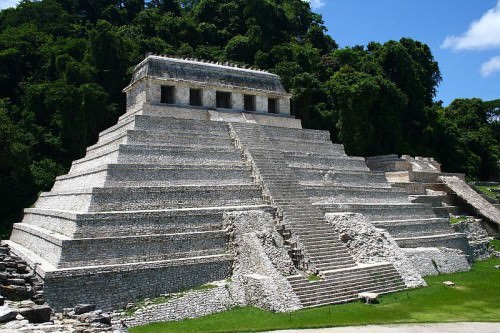
Temple of the Inscriptions, Palenque
The Classic Maya Period: 250-950 CE – This is the era which saw the consolidation of power in the great cities of the Yucatec Maya such as Chichen Itza and Uxmal. Direct cultural influences may be seen, in some sites, from the Olmecs and the Zapotecs and the cultural values of Teotihuacan and El Tajin but, in others, a wholly new culture seems to have emerged (such as at Chichen Itza where, though there is ample evidence of cultural borrowing, there is a significantly different style to the art and architecture). This period was the height of the Maya civilization in which they perfected mathematics, astronomy, architecture and the visual arts and also refined and perfected the calendar. The oldest date recorded in this era is on Stele 29 in the city of Tikal (292 CE) and the latest is from an inscription on the Stele at the site of Tonina (909 CE). The city-states of the Mayan civilization stretched from Piste in the north all the way down to modern-day Honduras.
The Post-Classic Period: 950-1524 CE – At this time the great cities of the Maya were abandoned. Thus far, no explanation for the mass exodus from the cities to outlying rural areas has been determined but climate change and over population have been strongly suggested among other possibilities. The Toltecs, a new tribe in the region, took over the vacant urban centers and re-populated them. At this time, Tula and Chichen-Itza became dominant cities in the region. The widely popular conception that the Maya were driven from their cities by the Spanish Conquest is erroneous as the cities were already vacant by the time of the Spanish invasion (in fact, the Spanish conquerors had no idea the natives they found in the region were responsible for the enormous complexes of the cities). The Quiche Maya were defeated at the Battle of Utatlan in 1524 CE and this date traditionally marks the end of the Maya Civilization.
MAYA CULTURE
The height of the Maya Civilization in the Classic Period produced the incredible cultural advances for which they are well known. The Maya believed deeply in the cyclical nature of life – nothing was ever `born' and nothing ever `died' – and this belief inspired their view of the gods and the cosmos. Their cosmological views, in turn, encouraged their imaginative efforts in architecture, mathematics, and astronomy. Beneath the earth was the dark realm of Xibalba (pronounced `shee-Bal-ba' and translated as `place of fear') from whence grew the great Tree of Life which came up through the earth and towered into the heavens, through thirteen levels, to reach the paradise of Tamoanchan (`place of the misty sky') where beautiful flowers bloomed. In Mayan belief, however, one did not die and go to a `heaven' or a `hell' but, rather, embarked on a journey toward Tamoanchan. This journey began in the dark and treacherous underworld of Xibalba where the Xibalbans who lived there were more apt to trick and destroy a soul than help one.
If one could navigate through Xibalba, however, one could then find the way to ascend through the nine levels of the underworld, and the thirteen levels of the higher world, to paradise. The only ways in which a soul could by-pass Xibalba and travel instantly to Tamoanchan were through death in childbirth, as a sacrificial victim, in warfare, on the ball court, or by suicide (the Maya had a special goddess of suicide named Ixtab who was depicted as the rotting corpse of a woman hanging by a noose in the heavens). Once one reached Tamoanchan there was eternal happiness but, it must be noted, this paradise was not thought to actually exist in the sky but on the earth. After ascending through the thirteen levels, one did not live in the air but, rather, on a mystical mountain back on the planet. It was because of this cyclical view that the Maya did not believe there was anything wrong with human sacrifice. Those people who were offered to the gods did not `die' but simply moved on.This cosmological belief influenced every aspect of the Mayan civilization and rituals were performed regularly in caves, evoking the darkness of Xibalba, and on hills or high temples which symbolized the heights of Tamoanchan.
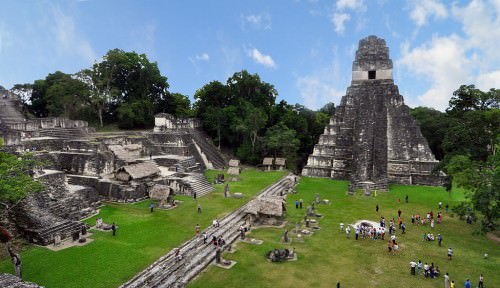
Tikal
The great pyramids which characterize so many Mayan sites are replicas of the great mountain of the gods known as the Witzob. The cyclical nature of human existence is mirrored in the famous Maya calendar. The depictions of the many gods and goddesses all go toward their function in helping one through the cycles of life or hindering. The great religious book of the Quiche Maya, the Popol-Vuh, tells precisely this story of the cyclical nature of life through the tale of the Hero Twins Hunahpu and Xbalanque and their victory over the forces of chaos and darkness symbolized by the Lords of Xibalba. The game the twins are famous for playing, Poc-a-Toc, serves the same purpose.
Poc-a-Toc was the most popular game among the Maya and was far more than `just a game' as it symbolized the human struggle and reflected the way the Maya viewed existence. Two opposing teams of seven men each would face each other on a ball court and try to score a small rubber ball through a vertical hoop affixed to a wall (sometimes as high as twenty feet in the air, sometimes higher) while defending their own goal. What makes the game even more impressive is that a player could not use the hands or the feet, only the hips, shoulders, head and knees. The Spanish bishop Diego de Landa wrote that watching the Maya play Poc-a-Toc was like watching lightning strikes, they moved so quickly. It has long been believed that the losing team (or the captain of the losing team) would be killed at the end of the match but recent advances in deciphering the Mayan glyphs, together with archaeological evidence, suggests it may have been the winning team or the winning captain who was given the honor of a quick death and instant passage to paradise. The game is thought to have been symbolic, not only of the victory of the hero twins over darkness, but of the cyclical nature of life. The Mayanists Schele and Matthews claim, "Many modern myths have grown up about the ballgame. The most popular says that the Maya sacrificed the winners so as to give a perfect gift to the gods. There is no evidence for this interpretation in any of the ancient or historical sources" (210). This is not quite correct, however, as glyphs at many ball courts, Chichen Itza to name only one, could be interpreted as showing the winning team or captain being sacrificed and modern Mayan daykeepers at both Altun Ha in Belize and Chichen Itza in the Yucatan point to the hope of escape from the darkness of Xibalba as the reason for the winners being executed. Whichever team was chosen to die, and under what circumstances (since teams could not have been continually sacrificed as there is evidence of `star' teams) the ball game was deeply meaningful to the Maya as more than just a spectator sport. More information on the particulars of the game, and the life of the ancient Maya in general, comes to light as more heiroglyphics are discovered and interpreted.
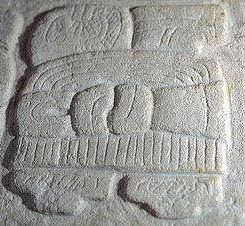
Maya Tikal Glyph
MAYAN HIEROGLYPHICS
The modern day difficulty in deciphering the Mayan hieroglyphics stems from the actions of the same man who, inadvertently, preserved so much of what we know of the Maya Civilization: Bishop Diego de Landa. Appointed to the Yucatan following the Spanish conquest of the north, Landa arrived in 1549 CE and instantly set himself to the task of routing out heathenism from among the Mayan converts to Christianity. The concept of a god who dies and comes back to life was very familiar to the Maya from their own deity The Maize God and they seem to have accepted the story of Jesus Christ and his resurrection easily. Even so, Landa believed that there was a subversive faction growing among the Maya which was seducing them `back to idolatry' and, having failed to crush this perceived rebellion through the avenues of prayer and admonition, chose another more direct method.
On 12 July 1562 CE, at the church at Mani, Landa burned over forty Mayan Codices (books) and over 20,000 images and stele. In his own words, “We found many books with these letters, and because they contained nothing that was free from superstition and the devil's trickery, we burnt them, which the Indians greatly lamented.” Landa went further, however, and resorted to torture to extricate the secrets of the subversives among the natives and bring them back to what he saw as the true path of the church. His methods were condemned by the other priests and he was called back to Spain to explain his actions. Part of his defense was his 1566 CE work Relacion de las Cosas de Yucatan which has preserved much of the culture Landa tried to destroy and has proved to be a valuable asset in understanding ancient Maya culture, religion, and language.
Only three books of the Maya escaped the conflagration at Mani: The Madrid Codex, The Dresden Codex, and The ParisCodex (so named for the cities where they were found many years after they were brought back from the Yucatan) which have provided scholars with a great deal of information on the beliefs of the Maya and, especially, on their calendar. The codices were created by scribes who made careful observations in astronomy (the Dresden Codex alone devotes six pages to accurately calculating the rising and positions of Venus ) and their interpretations of the planets and the seasons exhibit a precision unmatched by other ancient civilizations. So important were their stories and books to the Maya that the Legend of Zamna and the Hennequen Plant describes the great goddess telling the prophet Zamna:
I want you to choose a group of families from my kingdom, and three of the wisest Chilames, to carry the writings which tell the story of our people, and write what will happen in the future. You will reach a place that I will indicate to you and you will found a city. Under its main temple you will guard the writings and the future writings.
The city of Izamal was founded, according to this legend, by Zamna (associated with the deity Itzamna) of the Itzas who placed the sacred writings under the central temple. Izamal became known as the most important pilgrimage site in the Classical Period besides Chichen Itza. Shamans (known as Daykeepers) would interpret the particular energy of the day or month for the people by consulting with the gods presiding over the various months of the Maya calendar.
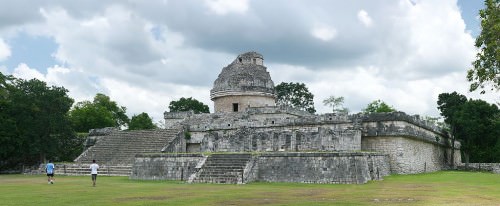
The Caracol, Chichen Itza
MAYA CALENDAR
There are two calendars at work simultaneously in the Maya system: the Haab, or civil calendar of 365 days in an 18 month period of 20 days each, and the Tzolkin, or sacred calendar, of 260 days divided into three groups of months of 20 days. The Haab and the Tzolkin work together, like gears interlocking in a machine, to create what is known as the Calendar Round but cannot account for dates farther in the future than 52 days. For longer calculations, the Maya devised what is known as the Long Count Calendar and is this which has attracted so much international attention in recent years regarding the end of the world on 21 December 2012 CE. As the long count calendar begins 11 August 3114 BCE, it goes into its next cycle (known as a Baktun) on 21 December 2012 CE.
There is nothing in the extant writings of the Maya to suggest any kind of cataclysm accompanies this transition. On 10 May 2012 CE it was reported that Boston University archaeologist William Saturno and Boston University student Maxwell Chamberlain, excavating at the Maya site of Xultun in Guatemala, discovered a 6x6 foot room dating to 800 CE which seems conclusively to have been a calendar workshop for Mayan scribes. The paintings and inscriptions on the walls of the room show the Maya calendar extending well beyond the year 2012 CE and that future Baktuns were understood to already be underway in the great cyclic dance of time. According to David Stuart, an expert on Maya hieroglyphs at the University of Texas at Austin, "Baktun 14 was going to be coming, and Baktun 15 and Baktun 16.... The Maya calendar is going to keep going, and keep going for billions, trillions, octillions of years into the future."
The months of the years of the Mayan calendars were governed over each by a specific god and, as these gods were eternal, they assured the continuance of the energy of their particular month. As all of life was considered one eternal cycle, the western concept of an `end of the world', so popular in Christian ideology, would have been a completely foreign concept to a Maya scribe.
MAYA TODAY
In the modern age the Maya still farm the same lands and travel the same rivers as their ancestors did from the north in the Yucatan down to Honduras. The claim that the Maya somehow vanished, simply because their cities were found abandoned, is not only inaccurate but insulting to the over six million Maya who carry on the traditions of their ancestors. Though the region was Christianized in the 16th century CE conquest and inquisition, the old ways are still observed in a hybrid between European Catholicism and Mayan mysticism. The Daykeeper of a village still interprets the energy of a day and rituals are still performed in caves and on hills. On the island of Cozumel shrines to the Virgin Mary and the goddess Ixchel are interchangeable and, often, one and the same. A great deal has been learned about the Maya since the days when Stephens and Catherwood explored and documented the ancient ruins but, for the Maya living today, nothing of importance has ever been forgotten and the cycle of life continues on.
LICENSE:
Article based on information obtained from these sources:with permission from the Website Ancient History Encyclopedia
Content is available under License Creative Commons: Attribution-NonCommercial-ShareAlike 3.0 Unported. CC-BY-NC-SA License